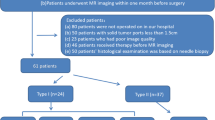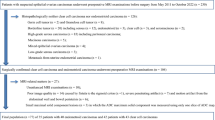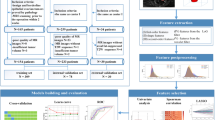Abstract
Objectives
Epithelial ovarian cancers (EOC) can be divided into type I and type II according to etiology and prognosis. Accurate subtype differentiation can substantially impact patient management. In this study, we aimed to construct an MR image–based radiomics model to differentiate between type I and type II EOC.
Methods
In this multicenter retrospective study, a total of 294 EOC patients from January 2010 to February 2019 were enrolled. Quantitative MR imaging features were extracted from the following axial sequences: T2WI FS, DWI, ADC, and CE-T1WI. A combined model was constructed based on the combination of these four MR sequences. The diagnostic performance was evaluated by ROC-AUC. In addition, an occlusion test was carried out to identify the most critical region for EOC differentiation.
Results
The combined radiomics model exhibited superior diagnostic capability over all four single-parametric radiomics models, both in internal and external validation cohorts (AUC of 0.806 and 0.847, respectively). The occlusion test revealed that the most critical region for differential diagnosis was the border zone between the solid and cystic components, or the less compact areas of solid component on direct visual inspection.
Conclusions
MR image–based radiomics modeling can differentiate between type I and type II EOC and identify the most critical region for differential diagnosis.
Key Points
• Combined radiomics models exhibited superior diagnostic capability over all four single-parametric radiomics models, both in internal and external validation cohorts (AUC of 0.834 and 0.847, respectively).
• The occlusion test revealed that the most crucial region for differentiating type Ι and type ΙΙ EOC was the border zone between the solid and cystic components, or the less compact areas of solid component on direct visual inspection on T2WI FS.
• The light-combined model (constructed by T2WI FS, DWI, and ADC sequences) can be used for patients who are not suitable for contrast agent use.



Similar content being viewed by others
Abbreviations
- ADC:
-
Apparent diffusion coefficient
- CE-T1WI:
-
Contrast-enhanced T1-weighted imaging
- DWI:
-
Diffusion-weighted imaging
- EOC:
-
Epithelial ovarian cancer
- MP:
-
Multi-parameter
- T2WI FS:
-
Fat-suppressed T2-weighted imaging
References
Soong TR, Kolin DL, Teschan NJ, Crum CP (2018) Back to the future? The fallopian tube, precursor escape and a dualistic model of high-grade serous carcinogenesis. Cancers (Basel) 10. https://doi.org/10.3390/cancers10120468
Lheureux S, Gourley C, Vergote I, Oza AM (2019) Epithelial ovarian cancer. Lancet 393:1240–1253. https://doi.org/10.1016/S0140-6736(18)32552-2
Kim A, Ueda Y, Naka T, Enomoto T (2012) Therapeutic strategies in epithelial ovarian cancer. J Exp Clin Cancer Res 31:14. https://doi.org/10.1186/1756-9966-31-14
Terraneo N, Jacob F, Dubrovska A, Grünberg J (2020) Novel therapeutic strategies for ovarian cancer stem cells. Front Oncol 10. https://doi.org/10.3389/fonc.2020.00319
Kurman RJ, Shih I-M (2008) Pathogenesis of ovarian cancer: lessons from morphology and molecular biology and their clinical implications. Int J Gynecol Pathol 27:151–160. https://doi.org/10.1097/PGP.0b013e318161e4f5
Kurman RJ, Carcangiu ML, Herrington CS, Young RH (2014) WHO classification of tumours of female reproductive organs. International Agency for Research on Cancer
Lalwani N, Prasad SR, Vikram R, Shanbhogue AK, Huettner PC, Fasih N (2011) Histologic, molecular, and cytogenetic features of ovarian cancers: implications for diagnosis and treatment. Radiographics 31:625–646. https://doi.org/10.1148/rg.313105066
Despierre E, Yesilyurt BT, Lambrechts S et al (2014) Epithelial ovarian cancer: rationale for changing the one-fits-all standard treatment regimen to subtype-specific treatment. Int J Gynecol Cancer 24:468–477. https://doi.org/10.1097/IGC.0000000000000089
Kurman RJ, Shih I-M (2010) The origin and pathogenesis of epithelial ovarian cancer: a proposed unifying theory. Am J Surg Pathol 34:433–443. https://doi.org/10.1097/PAS.0b013e3181cf3d79
Oh JW, Rha SE, Oh SN, Parka MY, Byuna JY, Lee A (2015) Diffusion-weighted MRI of epithelial ovarian cancers: correlation of apparent diffusion coefficient values with histologic grade and surgical stage. Eur J Radiol 84:590–595. https://doi.org/10.1016/j.ejrad.2015.01.005
Higano S, Yun X, Kumabe T et al (2006) Malignant astrocytic tumors: clinical importance of apparent diffusion coefficient in prediction of grade and prognosis. Radiology 241:839–846. https://doi.org/10.1148/radiol.2413051276
Kovač JD, Terzić M, Mirković M, Banko B, Đikić-Rom A, Maksimović R (2016) Endometrioid adenocarcinoma of the ovary: MRI findings with emphasis on diffusion-weighted imaging for the differentiation of ovarian tumors. Acta Radiol 57:758–766. https://doi.org/10.1177/0284185115599805
Wang F, Wang Y, Zhou Y et al (2017) Comparison between types I and II epithelial ovarian cancer using histogram analysis of monoexponential, biexponential, and stretched-exponential diffusion models: Comparison of Types I and II Ovarian Cancer. J Magn Reson Imaging 46:1797–1809. https://doi.org/10.1002/jmri.25722
Lambin P, Rios-Velazquez E, Leijenaar R et al (2012) Radiomics: Extracting more information from medical images using advanced feature analysis. Eur J Cancer 48:441–446. https://doi.org/10.1016/j.ejca.2011.11.036
Kumar V, Gu Y, Basu S et al (2012) Radiomics: the process and the challenges. Magn Reson Imaging 30:1234–1248. https://doi.org/10.1016/j.mri.2012.06.010
Gillies RJ, Kinahan PE, Hricak H (2015) Radiomics: images are more than pictures, they are data. Radiology 278:563–577. https://doi.org/10.1148/radiol.2015151169
Meng X, Xia W, Xie P et al (2018) Preoperative radiomic signature based on multiparametric magnetic resonance imaging for noninvasive evaluation of biological characteristics in rectal cancer. Eur Radiol. https://doi.org/10.1007/s00330-018-5763-x
Zhang Q, Xiao Y, Suo J et al (2017) Sonoelastomics for breast tumor classification: a radiomics approach with clustering-based feature selection on sonoelastography. Ultrasound Med Biol 43:1058–1069. https://doi.org/10.1016/j.ultrasmedbio.2016.12.016
Huang Y, Liang C, He L et al (2016) Development and validation of a radiomics nomogram for preoperative prediction of lymph node metastasis in colorectal cancer. J Clin Oncol 34:2157–2164. https://doi.org/10.1200/JCO.2015.65.9128
Wang X, Zhao X, Li Q et al (2019) Can peritumoral radiomics increase the efficiency of the prediction for lymph node metastasis in clinical stage T1 lung adenocarcinoma on CT? Eur Radiol. https://doi.org/10.1007/s00330-019-06084-0
Huang Y, Liu Z, He L et al (2016) Radiomics signature: a potential biomarker for the prediction of disease-free survival in early-stage (I or II) non—small cell lung cancer. Radiology 281:947–957
Song J, Shi J, Dong D et al (2018) A New Approach to Predict Progression-free Survival in Stage IV EGFR-mutant NSCLC Patients with EGFR-TKI Therapy. Clin Cancer Res 24:3583–3592. https://doi.org/10.1158/1078-0432.CCR-17-2507
Li H, Zhu Y, Burnside ES et al (2016) MR imaging radiomics signatures for predicting the risk of breast cancer recurrence as given by research versions of MammaPrint, Oncotype DX, and PAM50 gene assays. Radiology 281:382–391. https://doi.org/10.1148/radiol.2016152110
Nie K, Shi L, Chen Q et al (2016) Rectal cancer: assessment of neoadjuvant chemoradiation outcome based on radiomics of multiparametric MRI. Clin Cancer Res 22:5256–5264. https://doi.org/10.1158/1078-0432.CCR-15-2997
Nerad E, Lambregts DMJ, Kersten ELJ et al (2017) MRI for local staging of colon cancer: can mri become the optimal staging modality for patients with colon cancer? Dis Colon Rectum 60:385–392. https://doi.org/10.1097/DCR.0000000000000794
Zhang H, Mao Y, Chen X et al (2019) Magnetic resonance imaging radiomics in categorizing ovarian masses and predicting clinical outcome: a preliminary study. Eur Radiol. https://doi.org/10.1007/s00330-019-06124-9
Hauptmann S, Friedrich K, Redline R, Avril S (2017) Ovarian borderline tumors in the 2014 WHO classification: evolving concepts and diagnostic criteria. Virchows Arch 470:125–142. https://doi.org/10.1007/s00428-016-2040-8
Park MY, Hastie T (2007) L 1 -regularization path algorithm for generalized linear models. J R Stat Soc Series B Stat Methodology 69:659–677. https://doi.org/10.1111/j.1467-9868.2007.00607.x
Li Y, Jian J, Pickhardt PJ, et al MRI-based machine learning for differentiating borderline from malignant epithelial ovarian tumors: a multicenter study. J Magn Reson Imaging n/a: https://doi.org/10.1002/jmri.27084
Zeiler MD, Fergus R (2014) Visualizing and understanding convolutional networks. In: Fleet D, Pajdla T, Schiele B, Tuytelaars T (eds) Computer Vision – ECCV 2014. Springer International Publishing, Cham, pp 818–833
Lee CS, Baughman DM, Lee AY (2017) Deep learning is effective for classifying normal versus age-related macular degeneration OCT images. Ophthalmol Retina 1:322–327. https://doi.org/10.1016/j.oret.2016.12.009
Kermany DS, Goldbaum M, Cai W et al (2018) Identifying medical diagnoses and treatable diseases by image-based deep learning. Cell 172:1122–1131.e9. https://doi.org/10.1016/j.cell.2018.02.010
Muller P, Coates PJ, Nenutil R et al (2019) Tomm34 is commonly expressed in epithelial ovarian cancer and associates with tumour type and high FIGO stage. J Ovarian Res 12. https://doi.org/10.1186/s13048-019-0498-0
Funding
This study has received funding from the National Natural Science Foundation of China (No. 81871439, No. 81501439, No. 81571772, No. 81471628); Key R&D Program of Jiangsu (No. BE2017671); Shanghai Municipal Commission (No. 20184Y0049); Foundation of Jinshan Hospital, Shanghai Medical College, Fudan University (No. 2018-JSYYQH-03); and Science and Technology Commission Shanghai Municipality (No. 19411972000); and Chinese Academy of Sciences-Iranian Vice Presidency for Science and Technology Silk Road Science Fund (No. GJHZ1857).
Author information
Authors and Affiliations
Corresponding authors
Ethics declarations
Guarantor
The scientific guarantor of this publication is Jinwei Qiang.
Conflict of interest
Dr. Pickhardt is an advisor to Bracco and a shareholder in SHINE and Elucent. All remaining authors have declared no conflicts of interest.
Statistics and biometry
One of the authors has significant statistical expertise.
Informed consent
Written informed consent was waived by the Institutional Review Board.
Ethical Approval
Institutional Review Board approval was obtained.
Methodology
• retrospective
• diagnostic or prognostic study
• multicenter study
Additional information
Publisher’s note
Springer Nature remains neutral with regard to jurisdictional claims in published maps and institutional affiliations.
Electronic supplementary material
ESM 1
(DOCX 29 kb)
Rights and permissions
About this article
Cite this article
Jian, J., Li, Y., Pickhardt, P.J. et al. MR image-based radiomics to differentiate type Ι and type ΙΙ epithelial ovarian cancers. Eur Radiol 31, 403–410 (2021). https://doi.org/10.1007/s00330-020-07091-2
Received:
Accepted:
Published:
Issue Date:
DOI: https://doi.org/10.1007/s00330-020-07091-2




